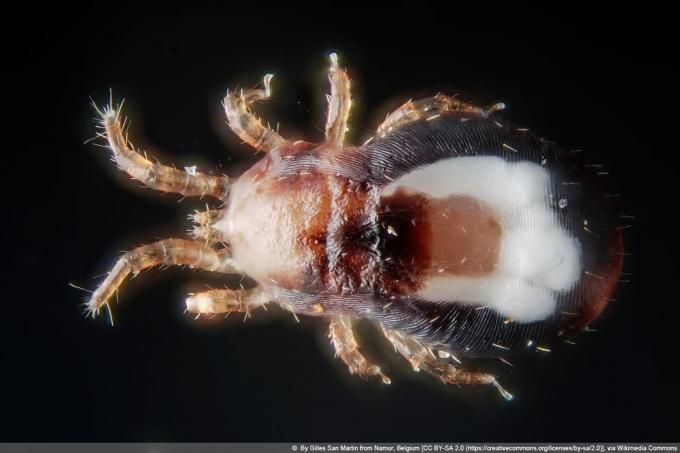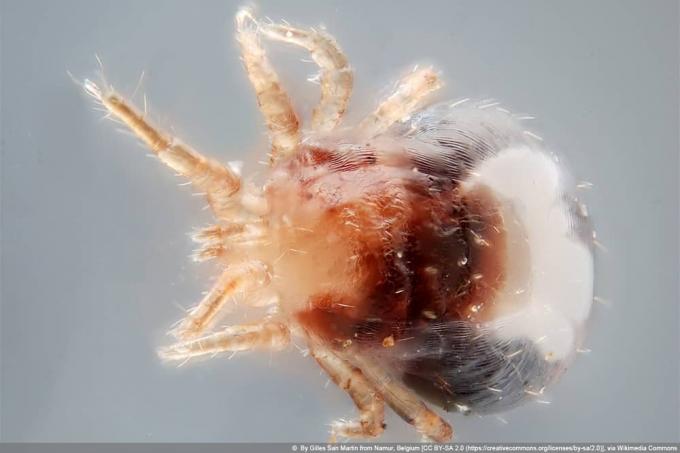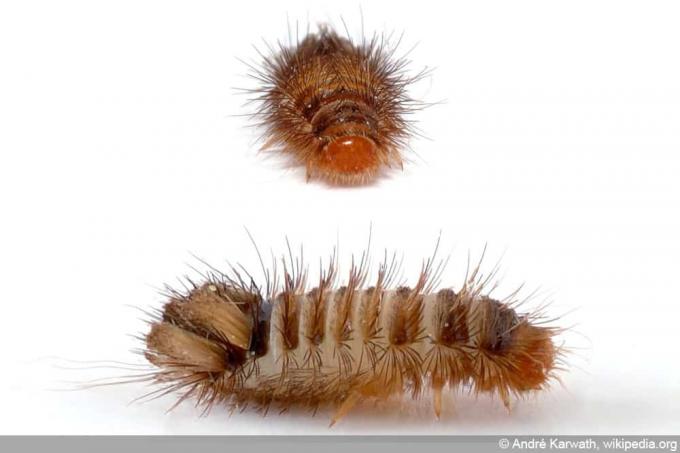

Table of contents
- How to recognize the red mite
- occurrence and habitat
- diet and behavior
- reproduction
- infestation in humans
- Potential health risks from bird mite infestation
- Combat acute infestation
- preventive measures
Dermanyssus gallinea, as the red mite is called in technical jargon, is one of the most common parasites not only found in birds, but in humans and animals in general. The blood-sucking animals cause itchy wheals and can transmit diseases. Due to their typical way of life, they are difficult to combat, which is why poultry farmers who are particularly at risk should pay more attention to prevention.
How to recognize the red mite
Due to its small size, the red mite (Dermanyssus gallinae), which is a predatory mite, can hardly be seen with the naked eye. especially since it only stays on its host for the short time it takes food and otherwise stays in cracks or cavities hidden. Male, adult animals are about 0.6 millimeters long, females are slightly larger at 0.7 to 0.8 millimeters. In addition, the females can become over a millimeter long by taking blood. The red mite belongs to the arachnids and, like all members of this class, has eight legs as an adult. Only in the larval stage do mites have six legs. Typically, Dermanyssus gallinae is whitish to gray in color (sometimes referred to as “gray fowl mite” for this reason), but appears red to brownish after blood sampling. For the layman, it can hardly be distinguished from other, similar-looking mite species.
occurrence and habitat
The red mite can be found all over the world. It feeds primarily on bird blood, both domestic and ornamental poultry as well as wild birds and birds. feral animals. Chickens, pigeons and geese are particularly affected, but also other host animals. The bird mite does not live directly on its host animal, but in its immediate vicinity, such as in protected niches, cracks, crevices and other small hiding places. These are often found in the birds' nests and in their cages (e.g. on the perches), but also on the wall, on the floor or in feeding containers.
diet and behavior
The larvae of the red mite do not yet take blood, only the nymphs - one Stage of development above the larvae - as well as the adult animals need the blood of their mostly feathered hosts. The mites seek out the host animal for food, especially directly before molting or laying eggs. The mites prefer to suck on the soft skin areas on the neck, around the shoulders, in the hollow of the knees and on the back. An adult mite takes about half an hour to feed.

The red mite is active from temperatures of at least 10 °C, but multiplies very quickly, especially in warm weather between 20 and 30 °C. The animals reproduce rapidly, so that very large populations can accumulate in sheltered places. The mite is not tied to its ancestral location, it can also search for places that are a little further away in search of a host. The red mite prefers to visit its host at night, but in some cases can also become active during the day. At temperatures below 10 °C, the animals survive up to nine months without any food.
reproduction
In typical poultry farms - for example a chicken coop - there are almost ideal living conditions for the red mite all year round. The arachnids find optimal conditions for survival and reproduction at temperatures between 20 and 30 °C and a Humidity of around 70% - here scientists were able to observe how an adult animal developed from an egg within just seven days developed. At temperatures between 15 and 25 °C, however, it can take up to 28 days for a red mite to go through all the stages of development. Each female mite lays between 30 and 100 eggs over the course of her life, with four to eight eggs per clutch. These are preferably not positioned on the host, but in its immediate vicinity - for example in superficial cracks and crevices. The larvae that hatch from them do not yet feed on blood.
infestation in humans
Mainly when their main hosts are not (any longer) available, bird red mites also bite other animals (e.g. pets such as dogs or cats) as well as humans. People who keep poultry or ornamental birds (such as budgerigars, etc.) themselves or who work in a poultry farm are particularly at risk. Furthermore, precautions should be taken by those near large accumulations of overgrown animals Domestic pigeons, wild pigeons or in a region with dense tree cover (e.g. near a park) resides. This is especially true for dwellings in the immediate vicinity of abandoned nests. Infestation often hits the residents of attic apartments, because pigeons, sparrows, swallows and other city birds nest preferably directly under the roof of a house - with the result that the mites can get into the apartment quickly and easily can. There are even reports of the red mite getting inside a hospital through ventilation shafts.
Potential health risks from bird mite infestation
The stings of the red mite cause severe itching in humans, red pustules form with a clear puncture mark in the middle. The actual sting is not noticed because the characteristic itching only appears hours later. Secondary infections can occur as a result of scratching, as a result of which the puncture site becomes inflamed. In principle, it is also possible for pathogens such as bacteria and viruses to be transmitted to humans by the mites. A red mite infestation is often associated with other mites or stinging bloodsuckers confused, since the skin reactions often do not allow a clear assignment and the animals rarely see are.
Tip:
poultry or Pet bird keepers can identify a suspected red mite infestation by wrapping the birds' perches with double-sided tape. The next morning, small dark or lighter spots should be found on it, which can be quickly identified as Dermanyssus gallinea under a microscope.
Combat acute infestation

The only way to combat an acute infestation of mites in your home is to thoroughly clean: clothing, bed covers and sheets, blankets, pillows, cuddly toys, etc. should be machine washed at temperatures above 50 °C. On the other hand, place loose objects that may serve as a hiding place and cannot be washed in the freezer or in the fridge overnight. into the freezer. Here, however, the little animals are only reliably killed at temperatures from minus 20 °C. For effective control, you should also find the source of the evil and finish off the little animals here with the appropriate chemical agents. This includes, for example, removing abandoned bird nests, for example under a gutter or in an attic. If the symptoms do not improve, you should consult a professional pest controller.
Tip:
First of all, a cooling, soothing gel or gel helps against the itching at a puncture site. an ointment.
preventive measures
If you keep birds, you should always ensure hygienic conditions in the aviary. This not only includes the cage or to regularly clean the chicken coop from droppings, but to keep both pores clean. Incidentally, the red mite (and other pests) are the reason why chicken coops used to be “burned out” and then whitewashed. Today, biocides such as acaricides are primarily used against mites, but these are not allowed to be used in homes occupied by people.
Tip:
Has a pigeon colony recently been evicted from your area? Then you have to be particularly careful, because countless mites then start looking for a new host.
 garden editorial
garden editorial I write about everything that interests me in my garden.
Learn more about home pests

Red maggots / larvae in the apartment: what to do?
Red maggots in your own home are the ultimate nightmare sight. A few crippling seconds of shock are allowed. But then decisive and effective action must be taken to make them disappear. But who exactly is "the red enemy" and how is the fight fought?

Compost bin powder against maggots: this is how it works
Especially in the warm season they can hardly be avoided: maggots in organic waste. In addition to insecticides, there is a far better way to keep the annoying guests away: powdered organic waste bins. We tell you how to use it and how it works.

Combat earwigs | 5 remedies against earworms in the apartment
Although earwigs, Dermaptera in Latin, are completely harmless and actually useful animals, the insects are still a cause for panic for many people when they appear in the apartment. Here you can find out how to get rid of the unloved crawlers.

Ants in the brickwork: you can do that now
Ants are useful insects, if they are in masonry they can cause damage to an object. An infestation is not easy to recognize, but if the first signs appear, you should act immediately. Simple home remedies are usually sufficient to drive away the insects.

Identify and fight fleas in the home
Even the thought of fleas in the home is uncomfortable. After all, we associate uncleanliness with annoying insects. They are considered carriers of dangerous diseases. Where are you from? What are the signs of a flea infestation? How do you get rid of them?

Fighting maggots on the ceiling | 7 tips for all rooms
Bedroom, kitchen or pantry, wall or ceiling - anyone who discovers maggots in the house wants to get rid of them quickly. With our help, you can do it quickly and without professional pest control.


